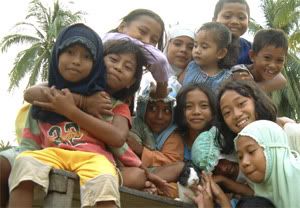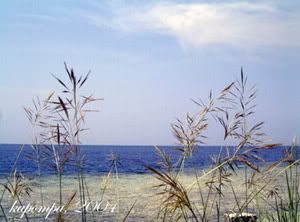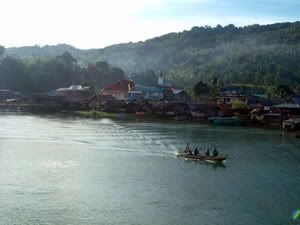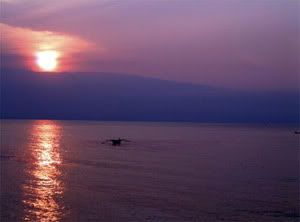we are here to stay
 The sun beats down mercilessly as I stepped out from the departure gate of Mutiara Airport in Palu, Central Sulawesi. It was not even high noon. I have an interview appointment with several groups of Internally Displaced People (IDPs) in three villages in Pamona Utara Subdistrict, somewhere around 300 km away from the dry city of Palu. The 2002 Toyota Kijang minivan took me skirting the Bay of Palu, getting ready to hike the hills of Tawaeli and reach Toboli on the other side of the coast in the next hour and a half.
The sun beats down mercilessly as I stepped out from the departure gate of Mutiara Airport in Palu, Central Sulawesi. It was not even high noon. I have an interview appointment with several groups of Internally Displaced People (IDPs) in three villages in Pamona Utara Subdistrict, somewhere around 300 km away from the dry city of Palu. The 2002 Toyota Kijang minivan took me skirting the Bay of Palu, getting ready to hike the hills of Tawaeli and reach Toboli on the other side of the coast in the next hour and a half.Out of the curvy and narrow roads prone to landslide from Tawaeli and Toboli, I emerged into the verdant coast of Parigi, where the road cut straight between the ocean on the left and rice fields on the right. Parigi demonstrated well-blend cultures of Bali, Javanese and local Sulawesi through houses with various structural designs, as well as house of prayers.
 “Welcome to Poso District” gave me a hint that Poso is dead ahead. The first stop was a Mobile Brigade post in Tumora, the first village in Poso District that has not been affected by the conflict. The car combed the Trans Sulawesi Highway of the Poso Pesisir Subdistrict. Compared to Tumora, where houses were mostly old and intact, Poso Pesisir exhibited an array of newly built wooden house – commonly referred as “Temporary Houses” (Rumah Tinggal Sederhana” -- RTS) and mushrooming new small shops in front of those houses. Charred houses and churches peeked among the “RTS”, dead witness of four years communal conflict in Poso District.
“Welcome to Poso District” gave me a hint that Poso is dead ahead. The first stop was a Mobile Brigade post in Tumora, the first village in Poso District that has not been affected by the conflict. The car combed the Trans Sulawesi Highway of the Poso Pesisir Subdistrict. Compared to Tumora, where houses were mostly old and intact, Poso Pesisir exhibited an array of newly built wooden house – commonly referred as “Temporary Houses” (Rumah Tinggal Sederhana” -- RTS) and mushrooming new small shops in front of those houses. Charred houses and churches peeked among the “RTS”, dead witness of four years communal conflict in Poso District.The town of Poso itself was bustling with life. Sentral Market in the middle of the town was at the peak of its business activities. It was the time of cocoa harvest. On the contrary to this normalcy, I stared blankly at the abandoned quarters of Lombogia and Madale, where scorched houses and wildly grown grass and plants replaced human beings.
 I continued my trip to Tentena in the afternoon, trekked through the hills of Pandiri and Sangira to see Lake Poso around the evening. Tentena is a smaller town than Poso. In some areas I spotted newly built wooden houses and small shops as well. I planned to visit the Villages of Sawidago, Saojo and Sulewana, where Christian IDPs from Poso Kota and Poso Pesisir chose to live.
I continued my trip to Tentena in the afternoon, trekked through the hills of Pandiri and Sangira to see Lake Poso around the evening. Tentena is a smaller town than Poso. In some areas I spotted newly built wooden houses and small shops as well. I planned to visit the Villages of Sawidago, Saojo and Sulewana, where Christian IDPs from Poso Kota and Poso Pesisir chose to live.It was around 10 o’clock when I set for Sawidago Village, a few minutes trip east of Tentena. I ended up in an area separated from the village center, a neighborhood cluster of its own that housed around 60-70 resettled IDP households. I met a group of simple women whose timidity was broken by them laughing at my rusty Central Sulawesi accent. These women mostly came from Madale in Poso Kota. They were farmers before the conflict broke and they were still farmers afterwards. Being stripped to poverty after loosing their belongings, having to flee their homes and resettled to a new place implied deep wounds, despite their acceptance to the present condition. What worried these women’s most were land’s condition, quickly changed mountain weather, land’s distance from their residences, growing children and increasing prices. Most of them had to allocate 20%-50% more funds to buy food, school fees and extra expenses for their children. With the present income and spending rates, as well as external economic conditions e.g. consumer goods prices and harvest-buy rate, the women expected to go back to their pre-conflict condition in 3-5 years time.
The day after, I set my feet to Saojo, a village by the road that connects Poso and Tentena. I met the IDP coordinator and a group of resettled IDPs. They mostly came from Lombogia and Kayamanya in Poso Kota. Most of them used to have permanent job with stable weekly to monthly income. When they were asked whether they have ever visited Poso Kota, a trace of silence enveloped us. Most of them said, since they fled Poso Kota in 2000, they returned only once to check their houses. But after seeing what was left of it they decided not to pay any visits anymore. For them, Lombogia was past tense and Saojo is the present and future. The resettled IDPs in Saojo that I met were mostly urban residents. They are not used to farming. They have had difficulties in cultivating their land. Information on how to properly cultivate their land and managing their crops were scarce. Despite that, these IDPs seemed to be better off than those in Sawidago. The Saojo resettled IDPs live in their own houses with the help of relatives in far away places. They only began farming sometime around 2003 since they have not been feeling safe beforehand. Those who do not farm well, preferred to work as traders or daily workers to anybody who needs their service.
Sulewana Village was my next destination. Hid behind dense trees along the main road of Poso-Tentena, resettled IDPs seemed to mix well with the local population, although adjusting to the life in a new place with new neighbors pose various challenges. Sulewana has bigger number of resettled IDPs who made several visits to Poso Kota and Poso Pesisir, their places of origin. They mostly went back for family and business visits. Most of them used to be farmers before the conflict and they are still doing it at the moment. A part from farming, to cover their daily expenses they work as daily workers to fellow resettled IDPs and local population. Most of them sell their harvest to middlemen who came to Sulewana. Prices are bought at pretty fair rate, since the resettled IDPs said they had to allocate more for public transportation if they had to sell their harvest to the market. The closest market is Tentena. When they asked whether they ever want to return back to the places of origin, some of them expressed their interest. They also argued that they had no problems whatsoever with their Moslem neighbors in their home villages, but they were more afraid of outsider Moslems. Most of the resettled IDPs in Sulewana already purchased land or land was given my local population, but it was the distance that limited their choices. They had to travel up to 10 kilometer daily and camped in the field for several days to work on their land and crops.
 It was clear that the IDPs have chosen to resettle in their newly found home towns. Their hope to go back to their places of origins is fading since there has been no security guarantee from the government. Their trauma has not fully recovered as they had endured three to four times violence since 1998 up to 2001. Most of them wish that better livelihoods opportunities are provided in terms of better seeds and types of crops that produce quick harvest and good prices. Access to market and fair price are also other matters that should be taken care of. A part from that, reviving communication and opening dividers between divided communities must be carefully thought. Any parties, either the government or non-government entities should talk and listen to these IDPs, whether there are still hope and whether it is feasible for divided communities to live side by side again.
It was clear that the IDPs have chosen to resettle in their newly found home towns. Their hope to go back to their places of origins is fading since there has been no security guarantee from the government. Their trauma has not fully recovered as they had endured three to four times violence since 1998 up to 2001. Most of them wish that better livelihoods opportunities are provided in terms of better seeds and types of crops that produce quick harvest and good prices. Access to market and fair price are also other matters that should be taken care of. A part from that, reviving communication and opening dividers between divided communities must be carefully thought. Any parties, either the government or non-government entities should talk and listen to these IDPs, whether there are still hope and whether it is feasible for divided communities to live side by side again.Labels: life











